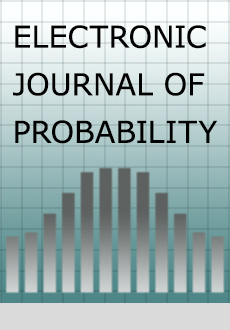Abstract
We consider a hypersurface of dimension $d$ imbedded in a $d+1$ dimensional space. For each $x\in Z^d$, let $\eta_t(x)\in R$ be the height of the surface at site $x$ at time $t$. At rate $1$ the $x$-th height is updated to a random convex combination of the heights of the `neighbors' of $x$. The distribution of the convex combination is translation invariant and does not depend on the heights. This motion, named the random average process (RAP), is one of the linear processes introduced by Liggett (1985). Special cases of RAP are a type of smoothing process (when the convex combination is deterministic) and the voter model (when the convex combination concentrates on one site chosen at random). We start the heights located on a hyperplane passing through the origin but different from the trivial one $\eta(x)\equiv 0$. We show that, when the convex combination is neither deterministic nor concentrating on one site, the variance of the height at the origin at time $t$ is proportional to the number of returns to the origin of a symmetric random walk of dimension $d$. Under mild conditions on the distribution of the random convex combination, this gives variance of the order of $t^{1/2}$ in dimension $d=1$, $\log t$ in dimension $d=2$ and bounded in $t$ in dimensions $d\ge 3$. We also show that for each initial hyperplane the process as seen from the height at the origin converges to an invariant measure on the hyper surfaces conserving the initial asymptotic slope. The height at the origin satisfies a central limit theorem. To obtain the results we use a corresponding probabilistic cellular automaton for which similar results are derived. This automaton corresponds to the product of (infinitely dimensional) independent random matrices whose rows are independent.
Citation
P.A. Ferrari. L. Fontes. "Fluctuations of a Surface Submitted to a Random Average Process." Electron. J. Probab. 3 1 - 34, 1998. https://doi.org/10.1214/EJP.v3-28
Information





